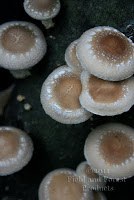Participants learned the step-by step process of inoculating logs with mushroom spore; the growing conditions for different types of mushrooms; and the nutritional and medicinal properties of mushrooms.

We gathered at Quiet Creek Herb Farm and School of Country Living for another information packed event. This time we learned about the art and science of growing Shiitake and Oyster Mushrooms. We started the day with a tour of the woodlot and a discussion about which trees to use for mushroom logs. Rusty Orner, one of the stewards of Quiet Creek Herb Farm, explained how they cut down trees, which will then re-sprout. They nurture those sprouts until they are large enough to use for mushroom logs also. He also demonstrated how a mushroom totem was built using three of the largest logs from the base of the tree. Another technique of growing mushrooms was to cut a long channel in a long log, inoculate it, seal it and let it rest under the existing trees. These are two techniques Rusty is experimenting with.
We then moved up to the inoculated log staging area. Here is where the first year logs are stacked to allow the spawn to run throughout the heartwood of the log. You may need to soak the logs periodically if there is not rain for a long period of time. The Orners store their logs under a group of evergreen trees because there can be no cross contamination from other fungi strains in these particular trees and the logs are protected. Rusty said that you do not want to store Shiitake and Oyster logs near each other because the Oyster is a more dominant spawn and will infect the Shiitake logs. The spawn will take 6-18 months to run depending on conditions and the size of the log. Rusty likes to stack his logs so that one end is touching the earth at all times. When you see the mycelium start to break the surface (it will look like someone spilled a small amount of milk on the bark) it is time push the mushroom growth. Take each log and thump it on the ground to activate the spawn and then lean the logs up at a 70 degree angle. Logs will begin to grow mushrooms. Most hardwoods will produce Shiitakes 1-2 times per season for 3-8 years if managed correctly. Rusty has written a booklet called Growing Shiitake in Western Pennsylvania which is available at the farm store. In his booklet he walks the reader through the entire mushroom growing process including wonderful illustrations.
The group then moved on to the inoculation station where we each inoculated out own Shiitake and Oyster log. We were given a catalog from Field & Forest Products, www.fieldforest.net, which sells different types of spawn as well as all the tools required to inoculate logs easily. Rusty demonstrated different tools such as a standard drill versus the Shiitake Express drill tool. Your wrist will tank you if you get a Shiitake Express! He also demonstrated different bits and inoculators.
After a busy morning of inoculating logs, we gathered in the upper room of the farm's store for a delicious lunch prepared by Claire Orner. We were treated to some of the mushrooms grown and harvested at the farm as well as tea made from their herbs. Claire then spoke about how mushrooms are used for medicinal purposes in different parts of the world. She described how to dry them and preserve them for later use. Claire then led the group in their own research activity to explore all the qualities they could find about shiitake and oyster mushrooms from the wide range of books and articles she had available. The group shared their findings and discussed the importance of the attributes they discovered. At the end of the day, each participant left with a booklet, catalog and two inoculated logs that will sprout luscious mushrooms in the future.
You can contact Quiet Creek Herb Farm at http://www.quietcreekherbfarm.org/ or 814-849-9662 to learn how to purchase Rusty's booklet or a mushroom log.
Pennsylvania Women's Agricultural Network
Address
302 Armsby BuildingUniversity Park, PA 16802
- Email pawagn@psu.edu
Pennsylvania Women's Agricultural Network
Address
302 Armsby BuildingUniversity Park, PA 16802
- Email pawagn@psu.edu

